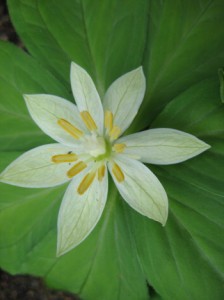Our human DNA has about 3 billion base pairs … so what would an organism with say … 150 billion base pairs look like? In fact it would look exactly like this …
 Yep, this little chap, known as Paris Japonica, has DNA that is far more complex than human DNA. The Royal Botanic Gardens, Kew, announced the discovery last week, and details appear in the September 2010 issue of the Botanical Journal of the Linnean Society. Sadly, it turns out that such complexity is really not an evolutionary advantage, its more of a burden.
Yep, this little chap, known as Paris Japonica, has DNA that is far more complex than human DNA. The Royal Botanic Gardens, Kew, announced the discovery last week, and details appear in the September 2010 issue of the Botanical Journal of the Linnean Society. Sadly, it turns out that such complexity is really not an evolutionary advantage, its more of a burden.
While this is indeed an amazing discovery, the DNA size highlights that this is a very rare plant and is most probably a gonner as far as evolution is concerned. What has been observed by past research is that the larger the genome, the greater the risk of evolutionary demise. Possibly this is due to the more complex DNA not being able to adapt quickly enough to change, so when the environment changes or pollution comes calling, its not able to adapt and survive.
Apparently, the more DNA you have, the longer it takes to grow, and so as a result this cute little flower can take about four years after planting before it even begins to sprout …the rare plants guide advises …
Paris japonica is a plant for the very patient gardener, with faith. It is at the opposite end of the spectrum to bedding annuals, it is not instant, nor even quick, but very very slow. Put it in the ground, about 5-10cm deep. It may not have a well-developed shoot on receipt but if it does, and if this is long, keep the rhizome at the depth advised with the shoot showing above the soil surface. It is best in a damp, well-drained, humus-rich soil in light shade. Never, ever pot it, not even in its first season just to make sure (second only to finger blight in gardener-related problems) then leave it alone, don’t lift it to check and in time you will be rewarded with a gorgeous plant.
Also … this is a very very picky plant … conditions must be just right … the rare plants guide advises (click here for details) …
It likes full or part shade, and humidity, it dislikes dry air and direct sun. It prefers plenty of humus in the soil and an acid to neutral soil. It dislikes limey soils and will not thrive in clay over limestone. It likes water but it dislikes bad drainage or over-dry soils. That behaviour all of its own that I mentioned? Well Paris, at the best of times, may not appear above ground in their first two or three years after planting. This is frustrating but it is normal behaviour for the genus. In the case of Paris japonica two years is a short wait, three or even four might be normal, yes really.
Ok, one more bit of trivia for you … the DNA from a single cell stretched out end-to-end would be taller than 300 feet …
All in all … its truly amazing.
Thought I’d just dip my little fly in your ointment and point out length isn’t necessarily indicative of complexity. :)